This July and August, we’re celebrating the release of Star Trek Beyond by taking a look back at the third season of the original Star Trek. Check back every Monday, Wednesday and Friday for the latest update.
Even the title feels morbid.
That Which Survives is sad and mournful. It is a story about returning, but wrong. It is the story of a dead world that by all accounts should not be, haunted by the image of a woman who has been dead for millennia. This spectre both is the original woman and is not; it is mechanical guardian that retains just enough of its subjects personality to be horrified by what it is doing. It is an unsettling premise, particularly for an episode that features Lee Meriwether menacing the crew with her arm outstretched while repeating “I am for you.”

The more, the Meriwether.
However, Losira is not the only character who “comes back wrong” over the course of the episode. Over the course of That Which Survives, the crew of the Enterprise are thrown throw space and find themselves racing to rescue Captain Kirk. However, mysterious malfunctions begin to affect the script. Eventually, Spock deduces the cause. “The Enterprise was put through a molecular transporter and reassembled slightly out of phase.” In other words, the Enterprise was taken apart and put back together wrong.
This seems like as an apt a metaphor for the third season as any. Star Trek had been killed at the end of its second season, cancelled by NBC. The show was resurrected for a third season, although it did not return at full strength. Vital members of the production team departed the show. The budget was cut. An outside producer with no previous experience of working on the show was drafted. For many watching at home, there was a sense that the third season had changed. In some ways, Star Trek had come back wrong.

“At least we got in before the purple rain.”
The basic plot of That Which Survives is incredibly straightforward. The Enterprise encounters a planet that seems to defy the laws of the universe, which seems to be happening quite a lot at this point in the run. As with The Tholian Web and Wink of an Eye, the episode makes a point to emphasise how improbable and unscientific all of this is; how fundamentally and innately wrong. There is a recurring sense across the third season that the show’s universe has begun to unravel, that things have stopped making sense.
Assessing Spock’s findings about the planet, Kirk reflects, “That would be difficult to explain.” Spock clarifies, “It would be impossible, Captain. An atmosphere could not evolve in so short a period of time.” He elaborates, “But the inconsistencies are so compounded as to present a seemingly impossible phenomenon.” So That Which Survives opens with Kirk encountering a planet that is presented as “impossible.” However, given that Wink of an Eye was essentially a story about the fair folk, it does not seem that unlikely.

Reconstructed.
Kirk promptly decides to send an investigative team down to the planet. Captain Kirk, Doctor McCoy, Lieutenant Sulu and Lieutenant D’Amato beam down to the surface of this impossible rock. No points for guessing which member of the away team dies in order to prove that the threat is credible. Before the end of the teaser, the entire planet rumbles and the Enterprise is thrown through space. Kirk and his team find themselves stranded on the planet alone, forced to survive. Meanwhile, Spock and Scott deal with the matter on the Enterprise.
Very little actually happens over the course of That Which Survives. The away team are stalked by the spectral image of a beautiful woman, who seems to bring death with her. The Enterprise nearly flies apart while at warp, but Scotty saves the day. Kirk eventually discovers that planet was built by a species millennia ago, who died out in a plague. The apparition is little more than an automated defense mechanism, a morbid twist on the classic alarm system. Having fixed the Enterprise, Spock beams in at the last minute. The plot is explained. Everybody leaves.

“Nope. Definitely can’t see the Enterprise. I’m sure we parked it somewhere up there.”
A lot of third season episodes suffer from being over-extended, a sense that the production team are taking thirty minutes worth of plot and extending it across forty-odd minutes. This is perhaps most obvious in the blatant padding during the final act of Let That Be Your Last Battlefield, but it is also true of the never-ending sword fights of Day of the Dove or the relentless humiliation of Plato’s Stepchildren. On paper, it seems like That Which Survives is liable to be more of the same, a skeleton plot stretched on far too long.
However, That Which Survives never drags. It never feels padded or bloated or over-extended. The plot is very simple and straightforward, but that is not the point of the exercise. The Which Survives feels almost like a tone poem, an exercise in mood. Very little actually happens, but the film is saturated by a sense of despair and isolation. If the plot moved faster, or covered more ground, That Which Survives would feel like an adventure. As it stands, it feels almost like a eulogy.

A bit of a fix.
That Which Survives was the second of three assignments given to Dorothy Fontana at the start of the season. In some ways, it was the least controversial. The Enterprise Incident became a bone of contention between Fontana and the new production team, with Fontana loudly objecting to the changes that were made to her script during the re-write process. That experience served to sour Fontana on the third season. However, the real fireworks would come during the development of the third story, the episode that would become The Way to Eden.
In contrast, That Which Survives seems to have simply been caught in the crossfire between the two. Fontana had been working on it for a while, until The Enterprise Incident become a higher priority and was bumped to the top of the season order. However, Fontana kept working on it in the background, even as her attention came to focus on the story that would develop into The Way to Eden. When Fontana fell out with Fred Freiberger over the changes to that third script, That Which Survives was cast aside as well.

It’s hip to be square.
As Fontana recounted to Starlog, this marked the end of her involvement with the series, but not with the franchise:
At that point, I realized I was in a no-win situation; and I told my agent to get me out of the contract — all of it, including the story sitting on the back burner (That Which Survives) and the option for three more. None of it was worth an ulcer — nor, I might add, is this dragging up of past differences of opinion and personality. And, of course, I did put pseudonyms on the two stories that were later used — The Way to Eden and That Which Survives.
I should also add that at the same time Mr. Freiberger was finding himself “a victim” of my so- called “non-professionalism,” I was writing two Lancer scripts, two High Chaparrals, and two Big Valley scripts for apparently satisfied producers. Further, Gene Roddenberry hired me in 1973 to be Associate Producer/Story Editor for the first season of Star Trek Animated and, to my knowledge, was satisfied with my season’s work.
Both That Which Survives and The Way to Eden were ultimately credited to “Michael Richards.”

“Well, look, Takei. One of us is going to have to start talking to the other.”
The task of developing the story into a script fell to former producer John Meredyth Lucas. Lucas had already contributed the script for (and directed) Elaan of Troyius earlier in the season. That Which Survives would turn out to be Lucas’ last credit on Star Trek, whether as writer or otherwise. He would later write the script Kitumba for the aborted Star Trek: Phase II, but this would be the last time that his work would make it to screen. Lucas did not have any strong recollection of the episode. In an interview in Starlog, he confessed that it “[didn’t] stir any memories.”
It could be argued that That Which Survives is an extension of some of the themes that defined Lucas’ short tenure as showrunner following the departure of Gene L. Coon. While Coon worked hard to populate and define the Star Trek universe with politics and empires, Lucas returned to the eerie haunted space aesthetic that defined a lot of the very early episodes. Towards the end of the second season, it frequently seemed like space was hostile to the very notion of human life.

Explosive confrontation.
Indeed, That Which Survives might fit comfortably with some of those late second season episodes. Losira is as deadly as the vampire cloud from Obsession; the sense of a collapsed society recalls The Gamesters of Triskelion or The Omega Glory, the refusal of the universe to conform to the crew’s expectations recalls the irrationality of The Immunity Syndrome. All of these ideas are filtered through the third season’s own fascinations with death and apocalypse, turning the intensity up on these themes.
In some respects, Lucas’ script can be seen as an attempt to pay homage to Fontana. There is a lot of humour and banter in the script, a lot of clever little character moments buried among the dialogue. Spock and Uhura have a conversation about Spock bumping his head during the Enterprise’s transport. Trying to deduce what happened, Sulu speculates, “Once in Siberia there was a meteor so great that it flattened whole forests and was felt as far away as–“ Kirk cuts him off, “Mister Sulu, if I’d wanted a Russian history lesson, I’d have brought along Mister Chekov.”

Between a rock and a hard place.
That said, Lucas lacks some of the finer character nuances that distinguish Fontana’s writing. Indeed, That Which Survives serves as a remind of just how well Fontana writes Spock, with Lucas awkwardly casting the half-Vulcan as a computer. Repeatedly over the course of the episode, Spock does impressive calculations and corrects rounding issues from the crew. It becomes a particularly groan-worthy recurring gag that in some ways prefigures the approach that certain writers on Star Trek: The Next Generation would take to Data.
“One thousand light years” is revised to be “nine hundred and ninety point seven light years.” Then “eleven and one half solar hours” becomes “eleven point three three seven hours.” Later, “fifteen minutes” becomes “fourteen point eight seven minutes.” It seems that Spock is quite fond of the decimal system. It is a somewhat reductive approach to the character, one that denies the fine characterisation that Fontana brought to bear on her interpretation of the show’s iconic science officer.

“Sssh.”
Lucas’ script seems to nod toward Fontana’s stylistic quirks in other regards. There is a surprisingly strong sense of continuity to the episode, much Fontana had a habit of maintaining character and plot continuity across her own scripts. When Kirk wonders if the rocks on the planet might be alive, Sulu responds, “You remember on Janus VI, the silicon creatures–“ It is a quick blink-and-you-miss-it continuity reference to The Devil in the Dark, in a rather obscure fashion for an era before the internet or home media.
Indeed, the episode even features a rare reappearance from a member of the crew. Star Trek did not have the deepest bench of recurring players, outside of a handful of crewmembers like Nurse Chapel or Yeoman Rand or Lieutenant Kyle. There were only a handful of crewmembers who appeared once or twice, rather than being relegated to full supporting players. Kevin Riley was one such example. He appeared in The Naked Time, and reappeared in The Conscience of a King owing to the fortuitous recasting of Bryce Hyde in what had been another role.
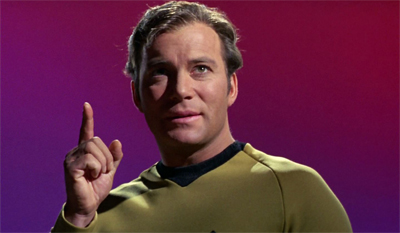
“Have you seen our ship? We left it right there.”
That Which Survives marks the second appearance of Booker Bradshaw as Doctor M’Benga. M’Benga had previously appeared in A Private Little War in the second season. According to Starlog, M’Benga was considered by the production team as a substitute for Christine Chapel:
During the lensing of A Private Little War, Bradshaw says he was assured that he would become a regular Enterprise crew member, but there was a strange catch. “I was told that I would be a regular on the show, but only when Nurse Chapel [Majel Barrett] had a headache. That’s how I got the second episode [That Which Survives].”
However, being a series regular wouldn’t have made Bradshaw jump for joy. “I liked Star Trek as a series,” he explains, “but truth be told, I hated that role. I was tired of playing doctors. I didn’t even like the name M’Benga. Years later. I was told by Nichelle Nichols [Uhura] that Trek conventions pay good money for guest speakers, but I declined. I told her, ‘I don’t want to live in my old pages.'”
It should be noted that Majel Barrett only appears as Christine Chapel in five of the final twelve episodes of the season, as compared to eight of the first twelve. These Are the Voyages reports that Fred Freiberger even replaced Barrett as the voice of the computer on Wink of an Eye.

Kirk’s plans go up in smoke.
These little touches and humour speak to the strengths of That Which Survives, an episode that uses a very simple story to offer a contemplative meditation on mortality. There is an impressive funereal tone suffused through the episode, a mournful reflection. When Lieutenant D’Amota is brutally murdered by the planet’s defense system, the episode devotes considerable time and energy to his passing. It seems like something that really affects the three survivors of the attack, unlike the red shirt deaths most typically featured on the show.
Upon finding the body, Kirk takes out his phaser. “Jim, what are you doing?” McCoy asks. Kirk responds, “Digging a grave.” It is a detail rarely seen; when it is seen, as in And the Children Shall Lead, it is seen only fleetingly. “What a terrible way to die,” Sulu reflects. Kirk offers his own wisdom, “There are no good ways, Sulu.” When the ground is unwilling to yield to Kirk’s phaser, unwilling to accept the away team’s dead, McCoy reflects, “I guess a tomb of rocks is the best we can provide for D’Amato.”

“Look, if I can’t remember Chekov doesn’t have a brother, I’m not likely to remember his D’Amot’s first name, am I?”
Of course, this whole sequence serves a very clear plot purpose. In trying to dig the grave with his phaser, Kirk discovers that the planet is constructed by a substance that “looks like igneous rock, but infinitely denser.” It suggests the unnatural origin of the planet, setting up a later reveal. Similarly, the burial scene might be a little more affecting if the makeshift tombstone read more than just “Lt. D’Amato”, if anybody on the team knew his first name. Still, the amount of time dedicated to D’Amato’s death is intriguing, and something that wouldn’t be possible in a busier episode.
Indeed, Losira herself is cast in a role clearly equivalent to death. Her name evokes the Egyptian deity Osiris, the goddess of the afterlife. She serves a similar function here, appearing to individual members of the away team. She visits D’Amato and Sulu while they are alone, on a deserted planet, with little hope of rescue. She knows them by name. She acts as if she has come to collect them. “You do not understand,” Osiris tells Sulu when he summons the rest of the team. “I have come for you.” She repeats, “I am for you.”
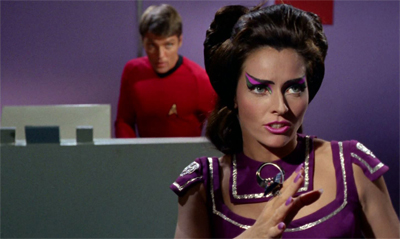
Crazy Cat(woman).
Losira is played by Lee Meriwether. In fact, That Which Survives is the first of three consecutive episodes to feature a prominent guest star who also appeared on Batman! Frank Gorshin appears in Let That Be Your Last Battlefield and Yvonne Craig guest stars in Whom the Gods Destroy. Meriwether described the role of Losira as a great challenge:
It was extremely difficult to play Losira because she was a computerized image, but she had a soul. She had been, when she was alive, really a wonderful, compassionate commander of the Kalandans and cared for her people so much, which you found out at the very end of the episode. She was so conflicted and I can tell you, even all these years later, having played Losira on Star Trek is helping me now in doing Long Day’s Journey into Night, which we’ll be performing at a theater near me in Studio City. Literally, you have to divide your mind for Long Day’s Journey, and that’s what I had to do for the first time when we did Star Trek. I had to kill, but not want to kill, but couldn’t be over-dramatic. You can’t telegraph that kind of thing or it will look false. So, playing Losira was a great challenge.
Losira is a very strange character, essentially acting as the base’s defense system while also carrying some residual personality from the base’s commander. The result is that Losira is at once both herself and not herself; she is a ghost haunting the planet, but a ghost that is alien even to herself. It perfectly captures the strange haunted quality of the episode.
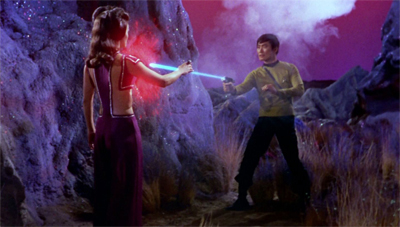
Stunning guest star.
(That said, this is the third season, so there is some rather strange ambient sexism in how That Which Survives approaches Losira. “Are there men on this planet?” Kirk pointedly asks during their first encounter. Given his interrogation of the Morg in Spock’s Brain, it seems like Kirk is very focused on gender roles in alien societies during this third season. The episode is very fixated on Losira’ beauty. Kirk reflects, “She must have been a remarkable woman.” McCoy adds, “And beautiful.” Asked if anything survives, Kirk reflects on Losira, “Beauty survives.”)
Losira works quite well as a metaphor for the legacy of war. She is an automated defense system on a world long abandoned. As the episode’s closing exposition dump explains, that mechanism was armed by a base desperately waiting for supplies. “I will set the outpost controls on automatic,” Losira states. “The computer will selectively defend against all life forms but our own.” Even thousands of years after she dies, that program is still dutifully protecting the base from outside intruders.
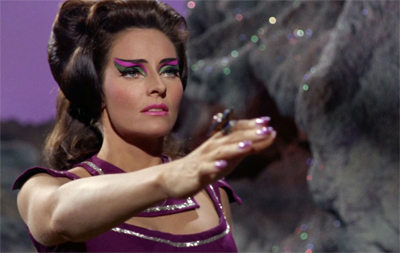
Touch of death.
The parallels are obvious. Losira would seem to be a metaphor for the legacy of warfare, the consequences of violence that linger on long after the direct aggression has ceased. Losira is a science-fiction spin on the idea of landmines or unexploded ordinance. Although the anti-landmine movement had yet to galvanise, these weapons would exist as a legacy of the War in Vietnam long after the United States eventually deescalated the conflict:
The Vietnamese government estimates that around 14m tonnes of ordnance, nearly three times that used by the Allies in the second world war, was dropped on Vietnam between 1959 and 1975. Between 10% and 30% of it failed to detonate. According to the most recent official figures, explosions caused by buried bombs and mines claimed around 105,000 civilian victims between 1975 and 2007. In total, the Vietnamese government estimates that around 15% of the total surface area of the country is contaminated by unexploded ordnance (UXO).
Indeed, even the process of minimising and removing this threat might have dire consequences. There are fears that the removing all of these mines and ordinance might expose undisturbed deposits of Agent Orange, which would then work their way back into the eco-system. It is no exaggeration to say that the Vietnam War is still killing people, even half a century later.
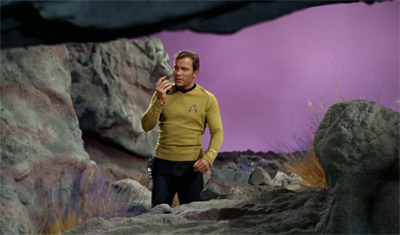
Rocky metaphor.
In this respect, That Which Survives serves as a blueprint for The Arsenal of Freedom. It is another example of how the third season of Star Trek seems to be preparing the franchise for later resurrection. The basic premise of That Which Survives would find itself recycled for the first season of The Next Generation, albeit in a clunkier and more heavy-handed fashion. The moral of That Which Survives is reserved for the final scene, while The Arsenal of Freedom blares it at full volume from the teaser.
Then again, it is a reminder of the show’s mortality. At this point in its run, Star Trek is not dying. Star Trek is dead. It has been dead from the moment that Kirk found himself cast in the role of Ike Clanton in Spectre of the Gun. It was probably dead at the point where Gene Roddenberry turned the cast into guest stars in a thinly-disguised pilot back in Assignment: Earth. Half-way through the third season, Star Trek has been dead a very long time. The show just hasn’t processed it yet.

“Thank goodness she just left this exposition lying around.”
Much like Wink of an Eye before it and Let That Be Your Last Battlefield after it, That Which Survives ends with an implied extinction. McCoy sums up the rather grim state of affairs, “The previous ships probably spread the disease all through their people. The supply ship that she was waiting for never came. All these thousands of years, she’s been waiting to greet people who were dead.” The planet was dead all along, it was just too stubborn to accept that. This is an episode where the primary guest star died thousands of years before the episode begins.
This haunted and funereal quality is reflected in a number of other ways. Most obviously, there is the strong purple colouring that saturates the episode. Star Trek always had a strong distinctive style, as demonstrated by episodes like Spectre of the Gun and The Empath. Indeed, the show featured countless worlds with skies in many colours. At the same time, the rich purples of That Which Survive are much stronger and more vivid than the traditional greens and reds. This is particularly striking during the scenes set at dusk on the planet surface. It seems eerie and strange.
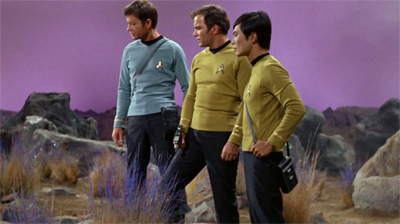
Survival instinct.
However, the script also contributes to the episode’s more ethereal qualities. At one point, Scott contacts the bridge with a vague and ominous observation. “Mister Spock, the ship feels wrong,” he warns the ship’s science officer. “I know it doesn’t make sense. Instrumentation reads correct, but the feel is wrong. It’s something I can’t quite put into words.” It turns out that Scott is correct. There is a tiny and almost imperceptible flaw in the Enterprise that threatens to destroy the ship. Much like Losira, the Enterprise was reconstructed. It came back wrong.
However, there is also some hope there. The ship can be repaired. Star Trek can return. Maybe Star Trek can survive.
You might be interested in our other reviews from the third season of Star Trek: The Original Series:
- Spectre of the Gun
- Elaan of Troyius
- The Paradise Syndrome
- The Enterprise Incident
- And the Children Shall Lead
- Spock’s Brain
- Is There in Truth No Beauty?
- The Empath
- The Tholian Web
- For the World is Hollow and I Have Touched the Sky
- Day of the Dove
- Plato’s Stepchildren
- Wink of an Eye
- That Which Survives
- Supplemental: Enterprising Individuals – Season 6, Episode 6
- Let That Be Your Last Battlefield
- Whom Gods Destroy
- The Mark of Gideon
- The Lights of Zetar
- Requiem for Methesulah
- The Way to Eden
- The Cloud Minders
- The Savage Curtain
- All Our Yesterdays
- Turnabout Intruder
- Supplemental: Standard Orbit #196 – “Star Trek Origins: Season 3”
Filed under: The Original Series | Tagged: ethereal, funereal, Ghost story, haunted, kirk, spock, star trek, that which survives |




















In her review of this episode, Plaid Adder says, “I don’t know what Shatner and Nimoy did to piss Lucas (and perhaps Fontana) off, but both Kirk and Spock act like dicks in this episode.” I’ve read a lot of FAN FICTION that has Kirk and Spock more in character than they are here. It’s possible that Lucas is just tone-deaf, but like Plaid Adder, I find myself wondering if it’s even possible to write Kirk and Spock this badly by accident.
Well, to be fair, the characterisation on the show was always variable.
Even David Gerrold makes some very astute observations about the differences in how Gene Roddenberry wrote Kirk as compared to Gene L. Coon; they might as well be two different characters. With Spock, Dorothy Fontana is very much the defining authorial voice. As script editor, she was able to preserve the character’s voice. Without her, Spock is very much “off” here, playing almost as a prototype version of Data than as the character he had always been.
Interesting theory? (I know your “Whom Gods Destroy” review is coming soon)
http://www.idigitaltimes.com/star-trek-discovery-cast-captain-garth-izar-maniacal-white-dude-fits-facts-nicely-551002
Ha! Thanks for the point to that.
Part of me really likes the idea, if only because it fits with the tropes that Fuller likes. After all, both Hannibal and American Gods are fond of their trickster/sinister mentor characters, and the idea that the lead character on Discovery won’t be the captain opens up that possibility. On the other hand, I wonder if Fuller might by self-aware enough to recognise it as one of his tropes. But you can just imagine Mads Mikkelsen sitting in the captain’s chair, and the first season building to that mutiny against him.
On the other hand, I’ve never been particularly good at the “guess how this will unfold from rumours and cryptic interview comments” game. And part of me also wonders if there have been enough “rogue Starfleet antagonists” after Star Trek Into Darkness and Star Trek Beyond.
It’s definitely intriguing. And Mads as Garth would be something else.
“When the Klingon hears the Romulan screaming, he comes running. But not to help.”
I hope that yu are ok.
I try.
That’s a really astute observation about Losira sounding like Osiris. I’m gonna get picky here and remind you Osiris is a guy. He is a harvest god, one who died and returned to life with the help of his wife Isis.
That’s a fair point.
I watched this episode for the first time (I am old but never really watched Star Trek) and found the scenes with Spock and Scotty quite amusing.